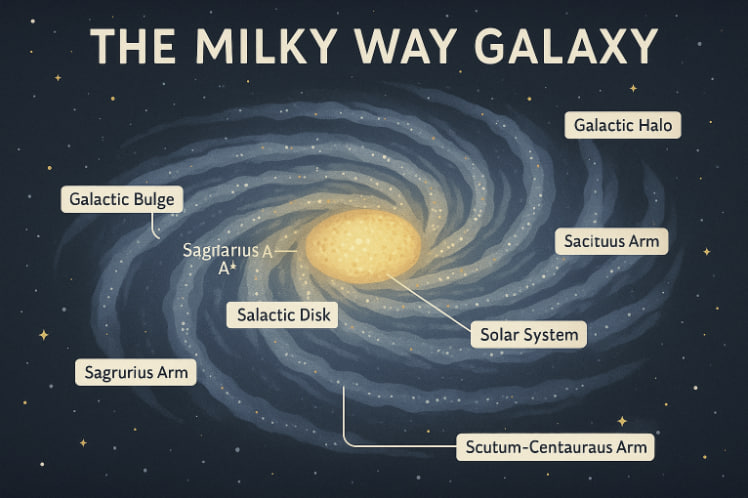We live inside a vast, spinning collection of stars, gas, dust, and dark matter called the Milky Way Galaxy. It stretches over 100,000 light-years in diameter, contains hundreds of billions of stars, and is shaped like a spiral disc. Despite living in it, most of us rarely think about where we are in this cosmic city—or how it’s built.
Let’s take a tour of our home galaxy and locate our position within it.
The Structure of the Milky Way
The Milky Way is classified as a barred spiral galaxy, meaning it has:
1. Galactic Bulge
- A dense, spherical region at the center, made mostly of old stars.
- Likely contains a supermassive black hole called Sagittarius A*, with about 4 million solar masses.
- The bulge is surrounded by a bar-shaped structure of stars.
2. Galactic Disk
- A flat, rotating disk containing spiral arms made of stars, gas, and dust.
- This is where star formation happens and where most visible stars lie.
- The disk is about 1,000 light-years thick and contains the majority of the galaxy’s mass.
3. Spiral Arms
- The Milky Way has several arms, including the Perseus Arm, Sagittarius Arm, Scutum-Centaurus Arm, and Outer Arm.
- Our Solar System lies on a small branch of the Sagittarius Arm known as the Orion Spur.
4. Galactic Halo
- A spherical region surrounding the disk, containing old stars, globular clusters, and dark matter.
- The halo extends far beyond the visible stars.
5. Dark Matter Halo
- Invisible, but thought to make up most of the galaxy’s mass.
- It holds the galaxy together gravitationally and affects the rotation speed of stars.
Where Are We in the Galaxy?
- Our Solar System is located about 26,500 light-years from the galactic center, roughly halfway between the core and the edge of the disk.
- We orbit the center at about 828,000 km/h (514,000 mph).
- One complete orbit of the galaxy (a galactic year) takes about 225–250 million Earth years.
- From Earth, we see the Milky Way band as a bright stripe in the night sky—this is the view along the dense plane of the disk.
How Do We Study Our Galaxy From Within?
Because we’re inside the Milky Way, we can’t see its full structure from the outside. But astronomers use:
- Infrared and radio telescopes to peer through dust.
- Star maps and motion tracking to trace spiral arms.
- Gravitational models to estimate the distribution of mass.
- Gaia mission: A European Space Agency satellite mapping over 1 billion stars in 3D.
Why It Matters
Understanding the structure of the Milky Way helps us:
- Explore how galaxies evolve
- Predict stellar movements and cosmic collisions
- Search for exoplanets and extraterrestrial life
- Estimate our future within the Local Group (a cluster of nearby galaxies)
Eventually, in 4–5 billion years, the Milky Way will merge with the Andromeda Galaxy, forming a new elliptical galaxy.
Glossary
- Light-year — The distance light travels in one year (~9.46 trillion km).
- Spiral arm — Curving structures in a galaxy’s disk rich in stars and gas.
- Galactic center — The dense core of a galaxy, often containing a black hole.
- Orion Spur — A small spiral feature between two major arms of the Milky Way.
- Galactic year — The time it takes the Sun to complete one orbit around the galaxy.


